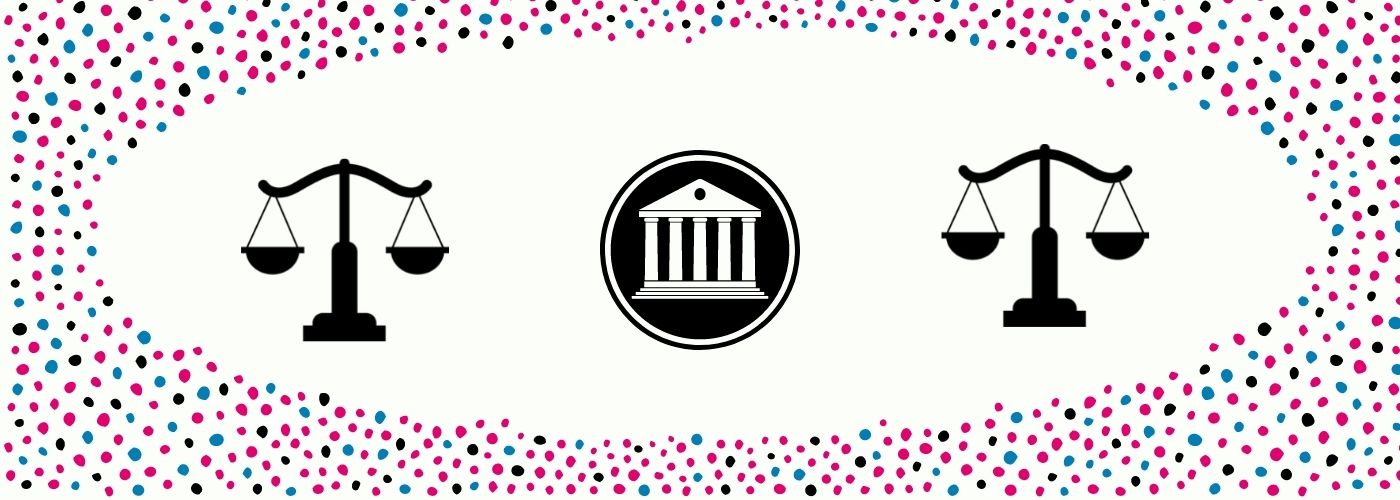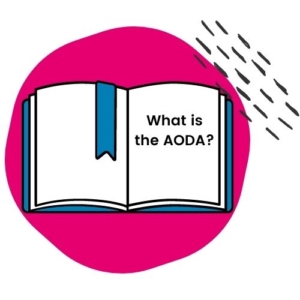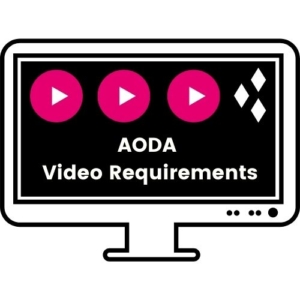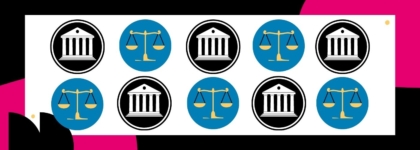AODA Video Requirements & Canadian Accessibility Standards
Updated: January 29, 2024
How the AODA Impacts Web and Online Video Accessibility [Free Ebook]
Ontario offers some of the most comprehensive web accessibility standards in the world.
The Accessibility for Ontarians with Disabilities Act (AODA) was instated in 2005 with the intention of creating a barrier-free Ontario by 2025. The AODA regulates accessibility standards across government, public, and private sectors, with requirements affecting five different areas of business: customer service, employment, information and communications, transportation, and design of public spaces. AODA compliance for video requirements, under WCAG, also mandates accessible video for people with disabilities.
The AODA standards aim to eliminate obstacles for people with disabilities in public and private life.
An Accessible Ontario by 2025
According to the Ontario Ministry of Community and Social Services, one in seven Ontarians has a disability. This number is expected to increase as people age, with disability affecting one in five people by 2036.
The Accessibility for Ontarians with Disabilities Act was passed to set an accessibility standard in which no person with a disability is prevented from fully participating in all aspects of society because of a disability. This commitment entails removing barriers, whether they be physical, architectural, technological, or informational. AODA video requirements also call for accessible video.
Importantly, the AODA seeks to include people with disabilities in the creation of official accessibility standards so their needs can be adequately met and their voices heard.
Three years after passing the AODA, Ontario passed the Accessibility Standards for Customer Service (Ontario Regulation 429/07), which focuses on creating accessible infrastructure in Ontario. This was followed in 2011 by the passage of the Integrated Accessibility Standards Regulation (Ontario Regulation 191/11), which sets standards for electronic communications.
Recent AODA Requirement Updates
With such a substantial overhaul to enact by 2025, the AODA set a series of phases toward full compliance. Each phase brought forth new requirements under the law. The following requirements became active under the AODA in 2020 and 2021:
Read on for AODA compliance regarding WCAG compliance and regulations for education, private businesses, and government.
WCAG Compliance
The AODA references Web Content Accessibility Guidelines (WCAG) 2.0 for specific standards to achieve.
Organizations covered by the AODA’s web accessibility standards must ensure all websites or content published after January 1, 2012, meet at least WCAG 2.0 Level AA.
Learn how the AODA impacts web and video accessibility in Ontario ➡️
What are the AODA video requirements?
The AODA video requirements mandate that if an Ontario-based organization uses online video at all, it must be made accessible. For video to be fully accessible to individuals with disabilities, it must have closed captioning for deaf or hard-of-hearing viewers and audio description or an alternative for blind or low-vision users.
Although there is a WCAG guideline for web designers to provide audio description for all visual content in videos, the AODA does not require audio description. Instead, creators and publishers can choose to implement this guideline as a best practice. Alternatively, they can make visual elements accessible in a different way, such as by providing transcripts that include both audio and visual elements.
Non-visual audio content must be accompanied by a transcript, and the media player in use must be keyboard accessible, meaning a user can navigate the controls without using a mouse.
Note that all websites and web content published after January 1, 2012, with minor exceptions, are required to comply with WCAG 2.0 Level AA. All websites and web content from The Government of Ontario and the Legislative Assembly must have conformed with WCAG 2.0 Level AA as of January 1, 2016.
How the AODA Applies to Education
Currently, there are no AODA education standards. However, there are recommendations of guidelines for K-12 institutations and colleges and universities. The AODA covers three different types of educational organizations:
Private schools with 50 or more employees and all public schools are subject to AODA regulations for web accessibility.
For these institutions, all websites and digital content must be accessible.
These educational institutions must also provide educational and training resources and materials in accessible formats upon request. For example, if a d/Deaf student cannot listen to a recorded lecture, they may ask to have the file captioned or request an ASL translator.
Schools must also train educators in accessibility awareness and how it relates to teaching.
The AODA extends to any publishers of educational materials, such as private textbook publishers, eLearning courses, university presses, and school boards.
As with schools, the rules apply to private organizations with 50+ employees and all public sector entities. All their web content must be accessible.
Large private libraries (50+ employees) and all public libraries adhere to the same deadlines as schools and educational publishers when it comes to making their websites accessible.
How the AODA Applies to Private Businesses
The AODA standards apply to all organizations, but requirements for private companies depend on a company’s size.
Companies with fewer than 20 employees must:
- Create accessibility policies
- Train staff and volunteers on accessibility requirements and customer service
- Plan for accessible and self-service kiosks if applicable
- Provide accessible customer service
- Implement accessible employment practices
- Provide accessible information upon request and at no additional cost
- Create accessible public spaces
In addition to all of the requirements of companies with fewer than 20 employees, companies with 20 to 49 employees must also:
- File an accessibility compliance report every three years
In addition to all of the requirements of smaller companies, large organizations (50 employees or more) must:
- Make all public websites accessible according to the World Wide Web Consortium’s Web Content Accessibility Guidelines (WCAG) 2.0.
How the AODA Applies to Government
As of January 1, 2016, all websites from the Government of Ontario and the Legislative Assembly must conform with WCAG 2.0 Level AA.
Municipal government bodies and public sector organizations in the province were required to make all their web content WCAG 2.0 Level AA compliant by January 1, 2021.
Learn about web accessibility in Ontario 💻
Penalties for Non-Compliance
Section 21(4) of the AODA states that those in violation of the regulations may be ordered to pay a fine and/or comply within a specific timeframe.
The charts below, sourced from The Integrated Accessibility Standards, outline the financial penalties of non-compliance with AODA.
Penalties for Individuals and Unincorporated Organizations
| Impact of Contravention: | Major | Moderate | Minor | |
| Contravention History: | Major | $2,000 | $1,000 | $500 |
| Moderate | $1,000 | $500 | $250 | |
| Minor | $500 | $250 | $200 | |
Penalties for Corporations
| Impact of Contravention: | Major | Moderate | Minor | |
| Contravention History: | Major | $15,000 | $10,000 | $5,000 |
| Moderate | $10,000 | $5,000 | $2,500 | |
| Minor | $2,000 | $1,000 | $500 | |
*A contravention is an action that violates a law, treaty, or other rulings.
In cases where the impact of contravention and contravention history are both determined to be major, the above amounts may be treated as a daily penalty with a maximum of $100,000 for corporations or $50,000 for individuals or unincorporated organizations.
AODA Compliant Employment, Training, and Hiring Practices
The AODA requires all employers to adhere to hiring, training, and management practices that do not discriminate against people with disabilities. The following digital or physical processes must be made fully accessible:
- New employee recruiting, vetting, and hiring
- Internal communications
- Performance assessments and management
- Development and advancement
- Workplace emergency response information
Employers should maintain documentation for individual accommodation plans, as well as a return-to-work process for temporary disabilities.
Deadlines for organizations to comply with these standards have already passed:
- January 1, 2016: Organizations with 50 or more employees
- January 1, 2017: Organizations with fewer than 50 employees
Exceptions
Ontario’s government clarified that the AODA compliance does not apply to internal (intranet) websites, nor to content published before 2012. However, if an individual requests that content posted before January 1, 2012, be made accessible to them in an alternate format (such as large print or braille), organizations must work with the individual to meet their needs.

This post was originally published in June 2016 by Emily Griffin and has been updated for freshness, accuracy, and comprehensiveness.
This blog post is written for educational and general information purposes only and does not constitute specific legal advice. This blog should not be used as a substitute for competent legal advice from a licensed professional attorney in your state.
Further Reading

Subscribe to the Blog Digest
Sign up to receive our blog digest and other information on this topic. You can unsubscribe anytime.
By subscribing you agree to our privacy policy.







